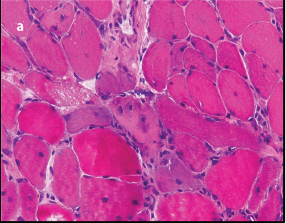Statin-associated immune-mediated necrotizing myopathy (IMNM) is a rare presentation of a statin-associated myopathy. Patients usually present with muscle weakness and pain in the setting of statin use with elevated creatine kinase (CK) levels and a positive anti-3-hydroxy-3-methylglutaryl-coenzyme A reductase (anti-HMGCR) antibody. Muscle biopsies typically show necrosis, CD68+ macrophages, and minimal lymphocytes. We present a case of a 67-year-old woman who had 2 months of progressive weakness and bilateral lower extremity pain after initiating atorvastatin therapy with symptoms persisting after statin cessation. She was found to have high anti-HMGCR antibody titers, and the biopsy of the rectus femoris muscle showed a prominent endomysial inflammatory cell infiltrate with necrotic and regenerative fibers and an atypical extensive inflammatory infiltrate composed of both CD4+ helper T cells and CD8+ cytotoxic T cells. She showed symptom resolution and normalization of CK levels and inflammatory markers with treatment involving a prolonged prednisone taper and a brief course of azathioprine, which was stopped because of the adverse effects.
Cite this article as: Zaki MM, Virk ZM, Lopez D, Klubnick J, Ahrendsen JT, Varma H, et al. A case of statin-associated immune-mediated necrotizing myopathy with atypical biopsy features. Eur J Rheumatol 2021; 8(1): 36-9.



.png)
